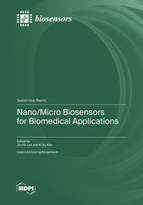Nano/Micro Biosensors for Biomedical Applications
A special issue of Biosensors (ISSN 2079-6374). This special issue belongs to the section "Biosensors and Healthcare".
Deadline for manuscript submissions: closed (30 September 2023) | Viewed by 37244
Special Issue Editors
Interests: biosensors; nanomaterials; stem cell differentiation
Special Issues, Collections and Topics in MDPI journals
Interests: biomaterials; biomedical application; theranostics; nanomedicine; biosensors
Special Issues, Collections and Topics in MDPI journals
Special Issue Information
Dear Colleagues,
The advances in nano/microtechnologies in recent years have significantly improved biosensors in terms of their viability for biomedical purposes, from diagnostic to therapeutic applications, allowing for effective early detection and personalized treatment modalities. Specifically, the introduction of a variety of nano/microtechnologies has offered new opportunities to improve the sensitivity, selectivity, response time, and biocompatibility of biosensors through outstanding physical, chemical, electrical and electrochemical properties.
Of great interest, this Special Issue aims to highlight the most recent and promising nano/microtechnologies utilized in the development of biosensors for biomedical applications. Thus, here we cordially invite you to contribute original research or review papers aligned with these themes, to lead the new approaches and solutions to a next-generation biosensor for biomedical applications.
Prof. Dr. Jin-Ho Lee
Prof. Dr. Ki Su Kim
Guest Editors
Manuscript Submission Information
Manuscripts should be submitted online at www.mdpi.com by registering and logging in to this website. Once you are registered, click here to go to the submission form. Manuscripts can be submitted until the deadline. All submissions that pass pre-check are peer-reviewed. Accepted papers will be published continuously in the journal (as soon as accepted) and will be listed together on the special issue website. Research articles, review articles as well as short communications are invited. For planned papers, a title and short abstract (about 100 words) can be sent to the Editorial Office for announcement on this website.
Submitted manuscripts should not have been published previously, nor be under consideration for publication elsewhere (except conference proceedings papers). All manuscripts are thoroughly refereed through a single-blind peer-review process. A guide for authors and other relevant information for submission of manuscripts is available on the Instructions for Authors page. Biosensors is an international peer-reviewed open access monthly journal published by MDPI.
Please visit the Instructions for Authors page before submitting a manuscript. The Article Processing Charge (APC) for publication in this open access journal is 2700 CHF (Swiss Francs). Submitted papers should be well formatted and use good English. Authors may use MDPI's English editing service prior to publication or during author revisions.
Keywords
- biosensors
- nano/micromaterials
- microsystem
- physical
- chemical
- electrical
- electrochemical








